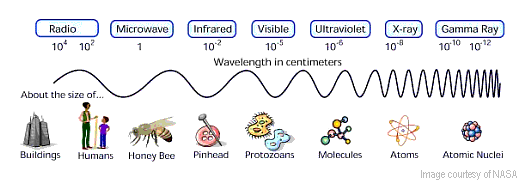LEDs are quickly replacing traditional light sources because of their energy efficiency and long life. This includes UV-LEDs, which are replacing traditional mercury tube UV lights, for disinfecting surfaces and the air. For more on the use of UV light to eliminate viruses and other pathogens, check out part 1 of our blog. This blog will focus on UV-LEDs and their capabilities.

Figure 1: The size of wavelengths
Light is classified as UV if its wavelength is between 100nm – 430nm. UV light is classified into three bands: UV-C (100 to 280nm), UV-B (280-315nm), and UV-A (315-315nm). Each band transmits a different amount of energy and has different effects on pathogens. With the shortest wavelength, the UV-C band of the spectrum is the most effective disinfectant. The UV-C band does not come from the sun, however, as most of it is blocked by the Earth’s ozone layer. The UV-C that is used for disinfecting comes from artificial light sources, such as mercury tubes and now, specialized UV-LEDs.
The disinfection dose can be calculated using the following formula: D = I x t / A where I is light intensity, t is exposure time, and A is surface area that is illuminated. The units of D are typically expressed as J/m2 or mJ/cm2, where 1 mJ/cm2 = 10 J/m2. The required dose is determined based on the properties of the pathogen and the desired level of disinfection, typically 99.9% or 99.99%.
For most pathogens, the wavelength with the peak DNA/RNA absorption is 265nm. At this frequency, the UV energy does the most damage to the pathogen, and disinfection is most effective. UV-LEDs, however, operate at 275 to 280nm. DNA/RNA absorption decreases as the frequency moves away from 265nm, and in the worst cases, goes down to about half at 280nm. To compensate for this decrease in absorption, the disinfection dose D should be multiplied by 2 to ensure sufficient disinfection.

Figure 2: DUV-LED disinfection efficiency vs. wavelength
The DNA/RNA of humans is damaged by UV-C light as much as any other DNA/RNA molecule. Protection should be worn in any environment with UV-C disinfection.
UV-A and Blue Light Disinfection
In Part 1 of this blog, we discussed using the sun for UV disinfection. The Spring Effect and Solar Water Disinfection (SODIS) show that disinfecting capabilities is not limited to UV-C; UV-A wavelengths and blue light can also be effective. UV-A and blue light cause oxidative stress and the formation of short-term radicals, which do damage to the pathogen as a whole. While not as effective as UV-C disinfection, UV-A and blue light have shown promise in removing pathogens.
Because UV-A and blue light are part of the natural spectrum that we see every day outdoors, they are much safer than UV-C. Safety is still a consideration; however, as many health issues, as well as material damage, is linked to excess sun exposure.
To learn more about how UV light can eliminate pathogens and viruses, take a look at LEDs Go Anti-Viral from EBV Elektronik
